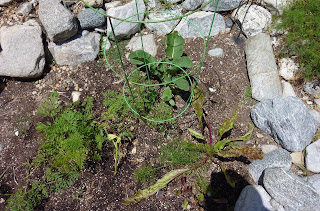It's been a long time since I've made a normal loaf of ordinary white bread. I didn't get into the sourdough craze because I don't like sourdough and I already have a pet. I went back to review my
original post on the bread ratio of ingredients, and it didn't even have a photo. Quite possible I didn't make a loaf then. It was the early days of blogging. So here's an improvement on that post, plus a lot more butter in the product.
I decided to make this as mini-loaves. It takes three mini-loaf pans to equal one full-sized loaf. That is true both for yeast and quick-bread recipes. What you change is the time it takes to bake. I can never manage to slice my own bread as thin as a machine can, so the mini loaves help me to portion control with the thicker slices. It's also great to find the loaf in the freezer you forgot about a few weeks later.
Not to say I'm great or anything, but this bread came out
very nice. It's basically self-buttered after the extra brushing step. It's what you always wish "butter-top bread" tastes like. You could have it with a meal, as a sandwich, or toasted up with jam.
*1 C milk
1/4 C butter, divided, plus more for pan
*1 tsp yeast
2 Tb sugar
~3 C flour
1 tsp salt
vegetable oil
1. Heat milk, 2 Tb butter, and sugar to 100º, about 1 minute in the microwave. Butter does not need to melt. I used actual butter this time, and unsalted. If you use salted butter or margarine, cut down the salt later to 1/2 tsp. Stir in yeast and allow to get foamy, about 5 minutes.
2. In mixer with the paddle, combine milk mixture and 1 C flour. Beat into a batter for 2 minutes. Add another cup of flour and the salt and beat again into a stringy dough for another 2 minutes.
3. Generously flour a work surface and turn out dough. Knead until smooth and elastic, working in as little flour as you can manage. This takes 5-10 minutes. Round into a ball. Lightly oil a bowl and turn dough to coat all sides. Let rise in the bowl in a warm place (100º-105º) until doubled, about an hour.
4. Punch down dough and allow to rest 10 minutes. Grease loaf pan (or pans) with butter. Melt remaining 2 Tb of butter and set aside for a minute. If dividing dough into multiple pans, I recommend using a scale. The dough should weigh roughly 22-26 ounces, depending on how much flour you ultimately worked in.
5. Roll out dough into a rectangle 1/4" thick. The wider side should be slightly wider than the width of the loaf pan. Brush surface with about 2/3 of the melted butter, like you were making a cinnamon roll. Roll up into a log, tuck under the ends, and set in loaf pan, seam-side down. If you ever wondered where the heel of the bread came from, it's the tucking under of the edges. It's going to look small in the pan, and possibly a little uneven or bowed in the middle.
6. Set pan in a warm place to rise for another hour, and watch the magic of yeast. Preheat oven to 375º and brush top of loaf with remaining butter. If desired, slit the top into a design about 1/2" deep so it can spread during the first phase of baking.
7. Bake 25-30 minutes (20 for minis), until medium gold and the loaf sounds hollow when thumped. Cool in pan for 5 minutes, then turn out to cool completely. Can be stored at room temperature for 2 days, or wrapped in foil and frozen for up to a month.
Makes 1 full loaf or 3 mini-loaves
Difficulty rating :)











































